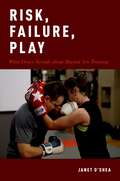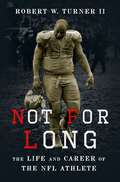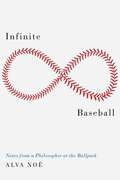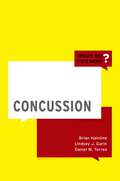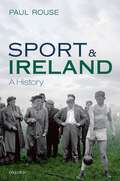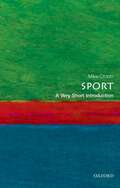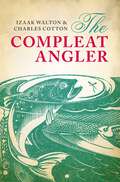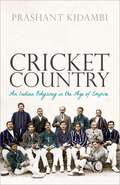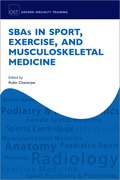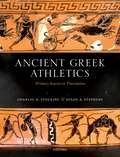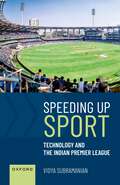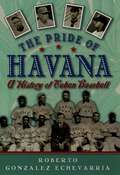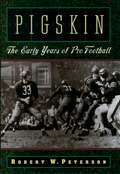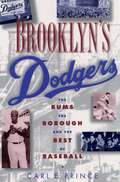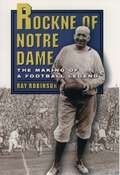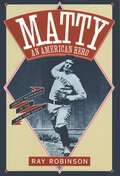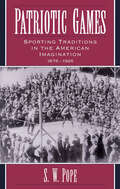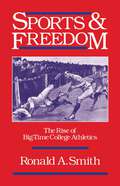- Table View
- List View
RISK, FAILURE, PLAY C: What Dance Reveals about Martial Arts Training
by Janet O'SheaRisk, Failure, Play illuminates the many ways in which competitive martial arts differentiate themselves from violence. Presented from the perspective of a dancer and writer, this book takes readers through the politics of everyday life as experienced through training in a range of martial arts practices such as jeet kune do, Brazilian jiu jitsu, kickboxing, Filipino martial arts, and empowerment self-defense. Author Janet OâShea shows how play gives us the ability to manage difficult realities with intelligence and demonstrates that physical play, with its immediacy and heightened risk, is particularly effective at accomplishing this task. Risk, Failure, Play also demonstrates the many ways in which physical recreation allows us to manage the complexities of our current social reality. Risk, Failure, Play intertwines personal experience with phenomenology, social psychology, dance studies, performance studies, as well as theories of play and competition in order to produce insights on pleasure, mastery, vulnerability, pain, agency, individual identity, and society. Ultimately, this book suggests that play allows us to rehearse other ways to live than the ones we see before us and challenges us to reimagine our social reality.
Not for Long: The Life and Career of the NFL Athlete
by Robert W. Turner IIThe NFL is the most popular professional sports league in the United States. Its athletes receive multimillion-dollar contracts and almost endless media attention. The league's most important game, the Super Bowl, is practically a national holiday. Making it to the NFL, however, is not about the promised land of fame and fortune. Robert W. Turner II draws on his personal experience as a former professional football player as well as interviews with more than 140 current and former NFL players to reveal what it means to be an athlete in the NFL and explain why so many players struggle with life after football. Without guaranteed contracts, the majority of players are forced out of the league after a few seasons. Over three-quarters of retirees experience bankruptcy or financial ruin, two-thirds live with chronic pain, and too many find themselves on the wrong side of the law. Robert W. Turner II argues that the fall from grace of so many players is no accident. The NFL, he contends, powerfully determines their experiences in and out of the league. The labor agreement provides little job security and few health and retirement benefits, and the owners refuse to share power with the players, making change difficult. And the process of becoming an elite football player--from high school to college and through the pros--leaves athletes with few marketable skills and little preparation for their first Sunday off the field. With compassion and objectivity, Not for Long reveals the life and mind of high school, college, and NFL athletes, shedding light on what might best help players transition successfully out of the sport.
Infinite Baseball: Notes from a Philosopher at the Ballpark
by Alva NoëBaseball is a strange sport: it consists of long periods in which little seems to be happening, punctuated by high-energy outbursts of rapid fire activity. Because of this, despite ever greater profits, Major League Baseball is bent on finding ways to shorten games, and to tailor baseball to today's shorter attention spans. But for the true fan, baseball is always compelling to watch -and intellectually fascinating. It's superficially slow-pace is an opportunity to participate in the distinctive thinking practice that defines the game. If baseball is boring, it's boring the way philosophy is boring: not because there isn't a lot going on, but because the challenge baseball poses is making sense of it all. In this deeply entertaining book, philosopher and baseball fan Alva Noë explores the many unexpected ways in which baseball is truly a philosophical kind of game. For example, he ponders how observers of baseball are less interested in what happens, than in who is responsible for what happens; every action receives praise or blame. To put it another way, in baseball - as in the law - we decide what happened based on who is responsible for what happened. Noe also explains the curious activity of keeping score: a score card is not merely a record of the game, like a video recording; it is an account of the game. Baseball requires that true fans try to tell the story of the game, in real time, as it unfolds, and thus actively participate in its creation. Some argue that baseball is fundamentally a game about numbers. Noe's wide-ranging, thoughtful observations show that, to the contrary, baseball is not only a window on language, culture, and the nature of human action, but is intertwined with deep and fundamental human truths. The book ranges from the nature of umpiring and the role of instant replay, to the nature of the strike zone, from the rampant use of surgery to controversy surrounding performance enhancing drugs. Throughout, Noe's observations are surprising and provocative. Infinite Baseball is a book for the true baseball fan.
Infinite Baseball: Notes from a Philosopher at the Ballpark
by Alva NoëBaseball is a strange sport: it consists of long periods in which little seems to be happening, punctuated by high-energy outbursts of rapid fire activity. Because of this, despite ever greater profits, Major League Baseball is bent on finding ways to shorten games, and to tailor baseball to today's shorter attention spans. But for the true fan, baseball is always compelling to watch -and intellectually fascinating. It's superficially slow-pace is an opportunity to participate in the distinctive thinking practice that defines the game. If baseball is boring, it's boring the way philosophy is boring: not because there isn't a lot going on, but because the challenge baseball poses is making sense of it all. In this deeply entertaining book, philosopher and baseball fan Alva Noë explores the many unexpected ways in which baseball is truly a philosophical kind of game. For example, he ponders how observers of baseball are less interested in what happens, than in who is responsible for what happens; every action receives praise or blame. To put it another way, in baseball - as in the law - we decide what happened based on who is responsible for what happened. Noe also explains the curious activity of keeping score: a score card is not merely a record of the game, like a video recording; it is an account of the game. Baseball requires that true fans try to tell the story of the game, in real time, as it unfolds, and thus actively participate in its creation. Some argue that baseball is fundamentally a game about numbers. Noe's wide-ranging, thoughtful observations show that, to the contrary, baseball is not only a window on language, culture, and the nature of human action, but is intertwined with deep and fundamental human truths. The book ranges from the nature of umpiring and the role of instant replay, to the nature of the strike zone, from the rampant use of surgery to controversy surrounding performance enhancing drugs. Throughout, Noe's observations are surprising and provocative. Infinite Baseball is a book for the true baseball fan.
Concussion (What Do I Do Now)
by Brian Hainline Lindsey J. Gurin Daniel M. TorresPart of the "What Do I Do Now? series, Concussion uses a case-based approach to cover common and important topics in the examination, investigation, and management of acute and subacute concussion. Each chapter provides a discussion of the diagnosis, key points to remember, and selected references for further reading. The book addresses a wide range of topics that run the spectrum from acute concussion to the possibility of long-term sequelae of concussion, and is suited for physicians and sports medicine clinicians. Concussion is an engaging collection of thought-provoking cases which clinicians can utilize when they encounter difficult patients. The volume is also a self-assessment tool that tests the reader's ability to answer the question, "What do I do now?"
Concussion (What Do I Do Now)
by Brian Hainline Lindsey J. Gurin Daniel M. TorresPart of the "What Do I Do Now? series, Concussion uses a case-based approach to cover common and important topics in the examination, investigation, and management of acute and subacute concussion. Each chapter provides a discussion of the diagnosis, key points to remember, and selected references for further reading. The book addresses a wide range of topics that run the spectrum from acute concussion to the possibility of long-term sequelae of concussion, and is suited for physicians and sports medicine clinicians. Concussion is an engaging collection of thought-provoking cases which clinicians can utilize when they encounter difficult patients. The volume is also a self-assessment tool that tests the reader's ability to answer the question, "What do I do now?"
Sport and Ireland: A History
by Paul RouseThis is the first history of sport in Ireland, locating the history of sport within Irish political, social, and cultural history, and within the global history of sport. Sport and Ireland demonstrates that there are aspects of Ireland's sporting history that are uniquely Irish and are defined by the peculiarities of life on a small island on the edge of Europe. What is equally apparent, though, is that the Irish sporting world is unique only in part; much of the history of Irish sport is a shared history with that of other societies. Drawing on an unparalleled range of sources - government archives, sporting institutions, private collections, and more than sixty local, national, and international newspapers - this volume offers a unique insight into the history of the British Empire in Ireland and examines the impact that political partition has had on the organization of sport there. Paul Rouse assesses the relationship between sport and national identity, how sport influences policy-making in modern states, and the ways in which sport has been colonized by the media and has colonized it in turn. Each chapter of Sport and Ireland contains new research on the place of sport in Irish life: the playing of hurling matches in London in the eighteenth century, the growth of cricket to become the most important sport in early Victorian Ireland, and the enlistment of thousands of members of the Gaelic Athletic Association as soldiers in the British Army during the Great War. Rouse draws out the significance of animals to the Irish sporting tradition, from the role of horse and dogs in racing and hunting, to the cocks, bulls, and bears that were involved in fighting and baiting.
Sport and Ireland: A History
by Paul RouseThis is the first history of sport in Ireland, locating the history of sport within Irish political, social, and cultural history, and within the global history of sport. Sport and Ireland demonstrates that there are aspects of Ireland's sporting history that are uniquely Irish and are defined by the peculiarities of life on a small island on the edge of Europe. What is equally apparent, though, is that the Irish sporting world is unique only in part; much of the history of Irish sport is a shared history with that of other societies. Drawing on an unparalleled range of sources - government archives, sporting institutions, private collections, and more than sixty local, national, and international newspapers - this volume offers a unique insight into the history of the British Empire in Ireland and examines the impact that political partition has had on the organization of sport there. Paul Rouse assesses the relationship between sport and national identity, how sport influences policy-making in modern states, and the ways in which sport has been colonized by the media and has colonized it in turn. Each chapter of Sport and Ireland contains new research on the place of sport in Irish life: the playing of hurling matches in London in the eighteenth century, the growth of cricket to become the most important sport in early Victorian Ireland, and the enlistment of thousands of members of the Gaelic Athletic Association as soldiers in the British Army during the Great War. Rouse draws out the significance of animals to the Irish sporting tradition, from the role of horse and dogs in racing and hunting, to the cocks, bulls, and bears that were involved in fighting and baiting.
Sport: Ireland's Sporting Heritage (Sport In The Global Society Ser.)
by Mike CroninSport is big business; international in nature and the focus of much media and cultural attention. In this Very Short Introduction, Mike Cronin charts the history of sport, from its traditional origins in folk football and cock fighting to its position as a global phenomenon today. Looking at a variety of sports from team games such as rugby, cricket, and football to games for individuals such as golf, tennis, and skiing, he considers how these first emerged and captivated the interest of ordinary people, and how sport has been transformed within our daily lives. Exploring the relationship between sport and class, gender, commerce, identity, and ethics, Cronin considers some of the central issues in sport today, including the high pay of professional footballers and the glamour of sports women, as well as fair play standards. Charting sport through the ages and around the world, this is a short guide to the history, development, and place of sport in contemporary global society. ABOUT THE SERIES: The Very Short Introductions series from Oxford University Press contains hundreds of titles in almost every subject area. These pocket-sized books are the perfect way to get ahead in a new subject quickly. Our expert authors combine facts, analysis, perspective, new ideas, and enthusiasm to make interesting and challenging topics highly readable.
The Compleat Angler (Oxford World's Classics)
by Izaak Walton Charles Cotton'I envy no body but him, and him only, that catches more fish than I do.' A unique celebration of the English countryside and the most famous book on angling ever published, Walton's Compleat Angler first appeared in 1653. In 1676, at Walton's invitation, his friend Charles Cotton contributed his pioneering exploration of fly-fishing. The book is both a manual of instruction and a vision of society in harmony with nature. It guides the novice fisherman on how to catch and cook a variety of fish, on how to select and prepare the best bait and make artificial flies, and on the habits of freshwater fish. It also promotes angling as a communal activity in which the bonds of friendship are forged through shared experience of the natural world. Anecdotes, poetry, music, and song intersperse the rural descriptions, which promote conservation as well as sport. This new edition highlights the book's continuing relevance to our relationship with the environment, and explores the turbulent history from which it came. ABOUT THE SERIES: For over 100 years Oxford World's Classics has made available the widest range of literature from around the globe. Each affordable volume reflects Oxford's commitment to scholarship, providing the most accurate text plus a wealth of other valuable features, including expert introductions by leading authorities, helpful notes to clarify the text, up-to-date bibliographies for further study, and much more.
SBAs in Sport, Exercise, and Musculoskeletal Medicine (Oxford Specialty Training: Revision Texts)
Candidates can prepare with confidence for postgraduate exams in sports and exercise medicine (SEM) with this revision guide. Containing over 400 SBA questions the content is carefully mapped to the Membership of Faculty of Sports and Exercise Medicine UK (MFSEM) curriculum ensuring comprehensive preparation. The Single Best Answer questions mirror the format of those candidates can expect to find in the MFSEM exam and many other postgraduate MSC SEM examinations globally. Explanatory answers include valuable background knowledge and references for further study. Each question and answer has been written to a high standard by some of the leading lights in SEM, orthopaedics, physiotherapy, rheumatology, radiology and musculoskeletal medicine as well as other specialties. Written by over 90 experts from the UK, Australia, the USA and Europe, this resource can help candidates preparing for entrance and final fellowship examinations of many international organisations including the ACSEP in Australia, UEMS in Europe and the CAQ in the USA. Providing a thorough assessment of the reader's Sports and Exercise Medicine knowledge, this is an invaluable resource for today's SEM student.
Ancient Greek Athletics: Primary Sources in Translation
by Charles H. Stocking Susan A. StephensThe Ancient Greek Athletics offers the most comprehensive collection to date of primary sources in translation for the study of ancient Greek athletics. Because Greek athletics was such an essential feature of both Greek and Roman culture, there is an especially strong need for proper treatment and understanding of the texts and other media used to reconstruct practices and ideologies of ancient athletics. The sources in this collection are arranged chronologically from the Archaic Period to the Roman Imperial Era, with an extensive appendix discussing key themes and topics. The organization and in-depth presentation of textual sources is designed to help students, scholars, and general readers fully appreciate the broader social and cultural significance of ancient Greek athletics as it developed in different historical time periods throughout antiquity.
Ancient Greek Athletics: Primary Sources in Translation
by Susan A. Stephens Charles H. StockingThe Ancient Greek Athletics offers the most comprehensive collection to date of primary sources in translation for the study of ancient Greek athletics. Because Greek athletics was such an essential feature of both Greek and Roman culture, there is an especially strong need for proper treatment and understanding of the texts and other media used to reconstruct practices and ideologies of ancient athletics. The sources in this collection are arranged chronologically from the Archaic Period to the Roman Imperial Era, with an extensive appendix discussing key themes and topics. The organization and in-depth presentation of textual sources is designed to help students, scholars, and general readers fully appreciate the broader social and cultural significance of ancient Greek athletics as it developed in different historical time periods throughout antiquity.
SBAs in Sport, Exercise, and Musculoskeletal Medicine (Oxford Specialty Training: Revision Texts)
by Robin ChatterjeeCandidates can prepare with confidence for postgraduate exams in sports and exercise medicine (SEM) with this revision guide. Containing over 400 SBA questions the content is carefully mapped to the Membership of Faculty of Sports and Exercise Medicine UK (MFSEM) curriculum ensuring comprehensive preparation. The Single Best Answer questions mirror the format of those candidates can expect to find in the MFSEM exam and many other postgraduate MSC SEM examinations globally. Explanatory answers include valuable background knowledge and references for further study. Each question and answer has been written to a high standard by some of the leading lights in SEM, orthopaedics, physiotherapy, rheumatology, radiology and musculoskeletal medicine as well as other specialties. Written by over 90 experts from the UK, Australia, the USA and Europe, this resource can help candidates preparing for entrance and final fellowship examinations of many international organisations including the ACSEP in Australia, UEMS in Europe and the CAQ in the USA. Providing a thorough assessment of the reader's Sports and Exercise Medicine knowledge, this is an invaluable resource for today's SEM student.
Speeding up Sport: Technology and the Indian Premier League
by Vidya SubramanianCricket has been the single most popular sport in India. In a technologically unmediated age, the game was played in the five-day test format. In 2007 though, the sport evolved itself into the Indian Premier League, an association that transformed it from mere a sport to an entertainment spectacle, raising its viewership, TRPs and popularity of the game, to hitherto unimaginable heights. The IPL consequently became India's first sporting platform. This book posits that the growth of the IPL (and of the popularity of cricket in contemporary India) has also been dependent on the parallel evolution of information and technology systems. The implications of technology have affected the way in which it can now be viewed by audiences on the television set at home; new technologies have affected umpiring decisions; new software are critically tied to generating digital audiences for the sport (it can be viewed on one's smartphone and e-devices); and in general, information and communication technology (ICT) has brought major interface between cricket players, administrators, brand managers, PR agencies and the audience. Developing ICTs as a real-time technological mediation has made the IPL dependent on the internet, television broadcast, Twitter, facebook and mobile phones. This book studies this impact; it studies not only how the sport has evolved in a post liberal India, but also how technology has affected the way it is viewed and spectated upon thereby altering the cultural and social milieu of the nation.
Speeding up Sport: Technology and the Indian Premier League
by Vidya SubramanianCricket has been the single most popular sport in India. In a technologically unmediated age, the game was played in the five-day test format. In 2007 though, the sport evolved itself into the Indian Premier League, an association that transformed it from mere a sport to an entertainment spectacle, raising its viewership, TRPs and popularity of the game, to hitherto unimaginable heights. The IPL consequently became India's first sporting platform. This book posits that the growth of the IPL (and of the popularity of cricket in contemporary India) has also been dependent on the parallel evolution of information and technology systems. The implications of technology have affected the way in which it can now be viewed by audiences on the television set at home; new technologies have affected umpiring decisions; new software are critically tied to generating digital audiences for the sport (it can be viewed on one's smartphone and e-devices); and in general, information and communication technology (ICT) has brought major interface between cricket players, administrators, brand managers, PR agencies and the audience. Developing ICTs as a real-time technological mediation has made the IPL dependent on the internet, television broadcast, Twitter, facebook and mobile phones. This book studies this impact; it studies not only how the sport has evolved in a post liberal India, but also how technology has affected the way it is viewed and spectated upon thereby altering the cultural and social milieu of the nation.
The Pride of Havana: A History of Cuban Baseball
by Roberto Gonzalez EchevarriaFrom the first amateur leagues of the 1860s to the exploits of Livan and Orlando "El Duque" Hernandez, here is the definitive history of baseball in Cuba. Roberto Gonzalez Echevarria expertly traces the arc of the game, intertwining its heroes and their stories with the politics, music, dance, and literature of the Cuban people. What emerges is more than a story of balls and strikes, but a richly detailed history of Cuba told from the unique cultural perch of the baseball diamond. Filling a void created by Cuba's rejection of bullfighting and Spanish hegemony, baseball quickly became a crucial stitch in the complex social fabric of the island. By the early 1940s Cuba had become major conduit in spreading the game throughout Latin America, and a proving ground for some of the greatest talent in all of baseball, where white major leaguers and Negro League players from the U.S. all competed on the same fields with the cream of Latin talent. Indeed, readers will be introduced to several black ballplayers of Afro-Cuban descent who played in the Major Leagues before Jackie Robinson broke the color barrier once and for all. Often dramatic, and always culturally resonant, Gonzalez Echevarria's narrative expertly lays open the paradox of fierce Cuban independence from the U.S. with Cuba's love for our national pastime. It shows how Fidel Castro cannily associated himself with the sport for patriotic p.r.--and reveals that his supposed baseball talent is purely mythical. Based on extensive primary research and a wealth of interviews, the colorful, often dramatic anecdotes and stories in this distinguished book comprise the most comprehensive history of Cuban baseball yet published and ultimately adds a vital lost chapter to the history of baseball in the U.S.
Pigskin: The Early Years of Pro Football
by Robert W. PetersonIf the National Football League is now a mammoth billion-dollar enterprise, it was certainly born into more humble circumstances. Indeed, it began in 1920 in an automobile showroom in Canton, Ohio, when a car dealer called together some owners of teams, mostly in the Midwest, to form a league. Unlike the lavish boardrooms in which NFL owners meet today, on this occasion the owners sat on the running boards of cars in the showroom and drank beer from buckets. A membership fee of $100 was set, but no one came up with any money. (As one of those present, George Halas, the legendary owner of the Chicago Bears, said, "I doubt that there was a hundred bucks in the room.") From such modest beginnings, pro football became far and away the most popular spectator sport in America. In Pigskin, Robert W. Peterson presents a lively and informative overview of the early years of pro football--from the late 1880s to the beginning of the television era. Peterson describes the colorful beginnings of the pro game and its outstanding teams (the Green Bay Packers, the New York Giants, the Chicago Bears, the Baltimore Colts), and the great games they played. Profiles of the most famous players of the era--including Pudge Heffelfinger (the first certifiable professional), Jim Thorpe, Red Grange, Bronko Nagurski, and Fritz Pollard (the NFL's first black star)--bring the history of the game to life. Peterson also takes us back to the roots of the pro game, showing how professionalism began when some stars for Yale, Harvard, and Princeton took money--under the table, of course--for their services to alma mater. By 1895, the money makers--still unacknowledged--had moved to amateur athletic associations in western Pennsylvania and subsequently into Ohio. After the NFL formed in 1920, pro football's popularity grew gradually but steadily. It burst into national prominence with the Bears-Redskins championship game of 1940. As one sportswriter put it: "The weather was perfect. So were the Bears." The final score was 73-0. Peterson shows how, after World War II, the newly-created All America Football Conference challenged the NFL. Though dominated by a gritty Cleveland team, the AAFC was never viewed by NFL teams as much of a threat. That is, not until 1950 when the two leagues merged, bringing about the Cleveland Browns-Philadelphia Eagles game in which the Browns buried the Eagles 35-10. An elegy to a time when, for many players, the game was at least as important as the money it brought them (which wasn't much), Pigskin takes readers up to the 1958 championship game when the Baltimore Colts beat the New York Giants in overtime. By that time, the great popularity of the game had moved from newspapers and radio to television, and pro football had finally arrived as a major sport.
Brooklyn's Dodgers: The Bums, the Borough, and the Best of Baseball, 1947-1957
by Carl E. PrinceDuring the 1952 World Series, a Yankee fan trying to watch the game in a Brooklyn bar was told, "Why don't you go back where you belong, Yankee lover?" "I got a right to cheer my team," the intruder responded, "this is a free country." "This ain't no free country, chum," countered the Dodger fan, "this is Brooklyn." Brooklynites loved their "Bums"--Pee Wee Reese, Jackie Robinson, Duke Snider, Roy Campanella, and all the murderous parade of regulars who, after years of struggle, finally won the World Series in 1955. One could not live in Brooklyn and not catch its spirit of devotion to its baseball club. In Brooklyn's Dodgers, Carl E. Prince captures the intensity and depth of the team's relationship to the community and its people in the 1950s. Ethnic and racial tensions were part and parcel of a working class borough; the Dodgers' presence smoothed the rough edges of the ghetto conflict always present in the life of Brooklyn. The Dodger-inspired baseball program at the fabled Parade Grounds provided a path for boys that occasionally led to the prestigious "Dodger Rookie Team," and sometimes, via minor league contracts, to Ebbets Field itself. There were the boys who lined Bedford Avenue on game days hoping to retrieve home run balls and the men in the many bars who were not only devoted fans but collectively the keepers of the Dodger past--as were Brooklyn women, and in numbers. Indeed, women were tied to the Dodgers no less than their husbands, fathers, brothers, and sons; they were only less visible. A few, like Pulitzer Prize-winning poet Marianne Moore and working class stiff Hilda Chester were regulars at Ebbets Field and far from invisible. Prince also explores the underside of the Dodgers--the "baseball Annies," and the paternity suits that went with the territory. The Dodgers' male culture was played out as well in the team's politics, in the owners' manipulation of Dodger male egos, opponents' race-baiting, and the macho bravado of the team (how Jackie Robinson, for instance, would prod Giants' catcher Sal Yvars to impotent rage by signaling him when he was going to steal second base, then taunting him from second after the steal). The day in 1957 when Walter O'Malley, the owner of the Brooklyn Dodgers, announced that the team would be leaving for Los Angeles was one of the worst moments in baseball history, and a sad day in Brooklyn's history as well. The Dodger team was, to a degree unmatched in other major league cities, deeply enmeshed in the life and psyche of Brooklyn and its people. In this superb volume, Carl Prince illuminates this "Brooklyn" in the golden years after the Second World War.
Rockne of Notre Dame: The Making of a Football Legend
by Ray RobinsonIn a mere twelve years, Rockne's "Fighting Irish" won 105 games, including five astonishing undefeated seasons. But Rockne was more than the sum of his victories--he was an icon who, more than anyone, made football an American obsession. The book gives us colorful descriptions of such Rockne teams as the undefeated 1924 eleven led by the illustrious Four Horsemen, and the 1930 squad, Rockne's last and greatest. A renowned motivator whose "Win one for the Gipper" is the most famous locker-room speech ever, Rockne was also football's most brilliant innovator, a pioneer of the forward pass, a master of the psychological ploy, and an early advocate of conditioning. In this balanced account, Rockne emerges as an exemplary and complex figure: a fierce competitor who was generous in victory and defeat; an inspiring father figure to his players; and a man so revered nationwide that when he died in a plane crash in 1931, at the height of his career, he was mourned by the entire country. "A solid portrait of one of football's most solid figures."--The New York Times Book Review
Matty: Christy Mathewson of the New York Giants
by Ray RobinsonWhen all-time pitching great Christy Mathewson died of tuberculosis in 1925 at the age of 45, it touched off a wave of national mourning that remains without precedent for an American athlete. The World Series was underway, and the game the day after Mathewson's death took on the trappings of a state funeral: officials slowly lowered the flag to half-mast, each ballplayer wore a black armband, and fans joined together in a chorus of "Nearer My God to Thee." Newspaper editorials recalled Mathewson's glorious career with the New York Giants, but also emphasized his unstinting good sportsmanship and voluntary service in World War I. The pitcher known to one and all as "Matty" or "Big Six" was as beloved for the strength of character he brought to the national pastime, as for his stunning 373 career victories. "I do not expect to see his like again," said his best friend and former manager, John McGraw. "But I do know that the example he set and the imprint he left on the sport that he loved and honored will remain long after I am gone." In Matty, Ray Robinson tells the story of a man who became America's first authentic sports hero. Until Mathewson, Robinson reveals, Americans loved baseball, but looked down on ballplayers and other athletes as hard-drinking, skirt-chasing ne'er-do-wells. Deprived of real-life role models, millions of readers followed the serialized exploits of Frank Merriwell, a fictional hero who excelled at sports from baseball to billiards and never drank, smoke, or swore. Robinson shows how an eager public greeted Mathewson as a flesh-and-blood version of Merriwell from his first year at Bucknell University, where he shone as star pitcher, premier field-goal kicker, and class president. Lured into the big leagues before he could graduate, the tall, handsome pitcher soon won over men, women and children with his sense of fair play and his arsenal of blazing fastballs, sweeping curves, and infamously deceptive fadeaway pitches. Robinson skillfully details the highlights of Mathewson's career, including his showdowns against the great batters of his day and his encounters with the young Brooklyn, Chicago, Pittsburgh and St. Louis teams. Here are the six remarkable days in October, 1905 when Mathewson became the only pitcher ever to hurl three straight shutouts in a World Series, and the afternoon at West Point when he won $50 in a bet that he could throw 20 of his best pitches to exactly the same spot. Robinson does not underplay Mathewson's occasional failings, but the most surprising aspect of this fascinating portrait is just how close America's first Hall of Fame pitcher came to living up to his image. Drawing on rare interviews, press clips, and long overlooked eyewitness accounts, Matty brings baseball's golden age to life--not only the great teams and the early superstars, but the long train trips between games, with cramped berths and no air conditioning; the small town ballplayers let loose amidst big city vice; and the two-bit gambling that eventually led to the infamous Black Sox Scandal of the 1919 Series (a scandal that might have escaped detection if the sportswriters in the press box with Mathewson had not been able to rely on his experienced eye for clues to how ballplayers might throw games). Offering rare insight into the making of an early twentieth century American hero, Matty is must reading for anyone who loves baseball.
Patriotic Games: Sporting Traditions in the American Imagination, 1876-1926 (Sports and History)
by S. W. PopeIn Patriotic Games, historian Stephen Pope explores the ways sport was transformed from a mere amusement into a metaphor for American life. Between the 1890s and the 1920s, sport became the most pervasive popular cultural activity in American society. During these years, basketball was invented, football became a mass spectator event, and baseball soared to its status as the "national pasttime." Pope demonstrates how America's sporting tradition emerged from a society fractured along class, race, ethnic, and gender lines. Institutionalized sport became a trans- class mechanism for packaging power and society in preferred ways--it popularized an interlocking set of cultural ideas about America's quest for national greatness. Nowhere was this more evident than the intimate connection established between sport and national holiday celebrations. As Pope reveals, Thanksgiving sports influenced the holiday's evolution from a religious occasion to a secular one. On the Fourth of July, sporting events infused patriotic rituals with sentiments that emphasized class conciliation and ethnic assimilation. In a time of social tensions, economic downturns, and unprecedented immigration, the rituals and enthusiasms of sport, Pope argues, became a central component in the shaping of America's national identity.
Sports and Freedom: The Rise of Big-Time College Athletics (Sports and History)
by Ronald A. SmithPerhaps more than any other two colleges, Harvard and Yale gave form to American intercollegiate athletics--a form that was inspired by the Oxford-Cambridge rivalry overseas, and that was imitated by colleges and universities throughout the United States. Focusing on the influence of these prestigious eastern institutions, this fascinating study traces the origins and development of intercollegiate athletics in America from the mid-nineteenth century to the early twentieth century. Smith begins with an historical overview of intercollegiate athletics and details the evolution of individual sports--crew, baseball, track and field, and especially football. Then, skillfully setting various sports events in their broader social and cultural contexts, Smith goes on to discuss many important issues that are still relevant today: student-faculty competition for institutional athletic control; the impact of the professional coach on big-time athletics; the false concept of amateurism in college athletics; and controversies over eligibility rules. He also reveals how the debates over brutality and ethics created the need for a central organizing body, the National Collegiate Athletic Association, which still runs college sports today. Sprinkled throughout with spicy sports anecdotes, from the Thanksgiving Day Princeton-Yale football game that drew record crowds in the 1890s to a meeting with President Theodore Roosevelt on football violence, this lively, in-depth investigation will appeal to serious sports buffs as well as to anyone interested in American social and cultural history.
